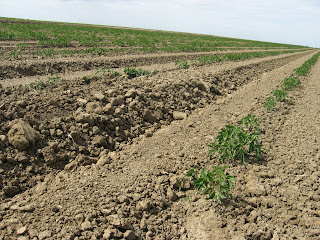We made at least two wrong turns getting to the mountains last month, and they helped put me in touch with my farming roots. In the middle of August the fields are lush with the bounty that gives California's Central Valley the name of The Greatest Garden in the World. Tomatoes, corn, cotton, walnuts, tree fruits, grapes... Wikipedia says that every non-tropical crop is grown here.
 On our second meander, in the northeasterly instead of southeasterly direction, we were surprised to see fig orchards on one side and pomegranates on the other. What could be more exotic or impossible? William Saroyan describes the impossibility in his 1930's story "The Pomegranate Trees" that Mr. Glad and I have laughed over a few times:
On our second meander, in the northeasterly instead of southeasterly direction, we were surprised to see fig orchards on one side and pomegranates on the other. What could be more exotic or impossible? William Saroyan describes the impossibility in his 1930's story "The Pomegranate Trees" that Mr. Glad and I have laughed over a few times:Melik plans to have apricots, peaches, figs and olives too, but he never gets beyond planting the pomegranates, which eventually fail, because instead of a fountain there is only a trickle of water flowing from the many wells he digs."My uncle Melik was just the worst farmer that ever lived. He was too imaginative and poetic for his own good. What he wanted was beauty. He wanted to plant it and see it grow. I myself planted over one hundred pomegranate trees for my uncle one year back there in the good old days of poetry and youth in the world. I drove a John Deere tractor too, and so did my uncle. It was all pure esthetics, not agriculture. My uncle just liked the idea of planting trees and watching them grow.
"Only they wouldn't grow. It was on account of the soil. The soil was desert soil. It was dry. My uncle waved at the six hundred and eighty acres of desert he had bought and he said in the most poetic Armenian anybody ever heard, Here in this awful desolation a garden shall flower, fountains of cold water shall bubble out of the earth, and all things of beauty shall come into being."
 |
| fig orchard in Madera Co. |
I do think there is nothing more lovely than a fig tree with its extravagant leaves on curvy branches, and fruits more refreshing than a cup of cold water. Though I grew up in the Valley this was my first sighting of a groveful. I didn't notice what kind of irrigation system is used in the orchard, but no doubt there was one.
 |
| View of Sierras from Tulare County (Pippin pic) |
 |
| Tulare Co. in Spring - still green in places |
When you drive across the state, from a dammed mountain lake to San Francisco Bay Area in one day, the repetition of scenes along the highway impresses on you the importance of water. There are dead almond orchards on Highway 5, on the "West Side" of the Valley, that testify to water wars still going on, and to our inability to grow very much without irrigation.
 |
| Westside tomato field in April |
I recalled my sweaty and tanned father getting off his tractor, coming into the house mid-afternoon with a watermelon and slicing it into rounds at the kitchen counter. He'd put one big slice on a plate and eat it with a fork before going back out to take care of his orange trees.
Water melon. Melons are some of those things of beauty that Uncle Melik likely envisioned as he was trying to find their necessary water. And the people who tend the earth's gardens, who are willing to build the dams and plant the trees and irrigate them all summer long are beautiful to me, too.
 |
| the house where my father ate watermelon |
Gardening requires lots of water -
most of it in the form of perspiration.
~Lou Erickson

5 comments:
What a lovely post. Most of my blogger friends live on the east coast so it is nice to read about how great our valley is and how much it does grow here. When my parents moved away after living here all of their lives they would talk of missing all of the fruit and vegetables. We are blessed to live here.
I love the pictures and yes, I am so surprised as I drive up the valley to see the hundreds and hundreds of Pomegranates too. I am glad you had such a lovely drive.
That Lou Erickson quote...PERFECT!
Water is truly a necessity of life, more than we often think.
Thank you, California, for the lovely and good fruits and veggies you provide us. I am sorry to hear that there are still water wars going on that stop production of these good foods. It frustrates me.
Beautiful pic of your old home. I'm headed out to the fenceline to bring ice cold water (no watermelon) and a snack to the men and to join them in their work.
What a lovely memory to span the wide valley from the coastal mountains to the Sierras and the the generations from those who have gone on before and those still coming...
Post a Comment